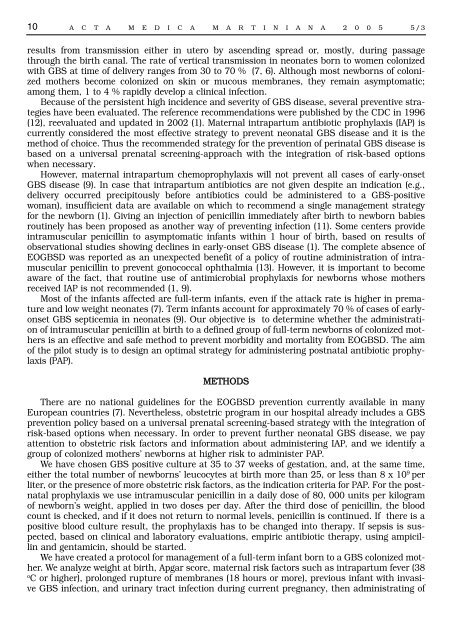MAKETA 5/3
MAKETA 5/3
MAKETA 5/3
You also want an ePaper? Increase the reach of your titles
YUMPU automatically turns print PDFs into web optimized ePapers that Google loves.
10<br />
A C T A M E D I C A M A R T I N I A N A 2 0 0 5 5/3<br />
results from transmission either in utero by ascending spread or, mostly, during passage<br />
through the birth canal. The rate of vertical transmission in neonates born to women colonized<br />
with GBS at time of delivery ranges from 30 to 70 % (7, 6). Although most newborns of colonized<br />
mothers become colonized on skin or mucous membranes, they remain asymptomatic;<br />
among them, 1 to 4 % rapidly develop a clinical infection.<br />
Because of the persistent high incidence and severity of GBS disease, several preventive strategies<br />
have been evaluated. The reference recommendations were published by the CDC in 1996<br />
(12), reevaluated and updated in 2002 (1). Maternal intrapartum antibiotic prophylaxis (IAP) is<br />
currently considered the most effective strategy to prevent neonatal GBS disease and it is the<br />
method of choice. Thus the recommended strategy for the prevention of perinatal GBS disease is<br />
based on a universal prenatal screening-approach with the integration of risk-based options<br />
when necessary.<br />
However, maternal intrapartum chemoprophylaxis will not prevent all cases of early-onset<br />
GBS disease (9). In case that intrapartum antibiotics are not given despite an indication (e.g.,<br />
delivery occurred precipitously before antibiotics could be administered to a GBS-positive<br />
woman), insufficient data are available on which to recommend a single management strategy<br />
for the newborn (1). Giving an injection of penicillin immediately after birth to newborn babies<br />
routinely has been proposed as another way of preventing infection (11). Some centers provide<br />
intramuscular penicillin to asymptomatic infants within 1 hour of birth, based on results of<br />
observational studies showing declines in early-onset GBS disease (1). The complete absence of<br />
EOGBSD was reported as an unexpected benefit of a policy of routine administration of intramuscular<br />
penicillin to prevent gonococcal ophthalmia (13). However, it is important to become<br />
aware of the fact, that routine use of antimicrobial prophylaxis for newborns whose mothers<br />
received IAP is not recommended (1, 9).<br />
Most of the infants affected are full-term infants, even if the attack rate is higher in premature<br />
and low weight neonates (7). Term infants account for approximately 70 % of cases of earlyonset<br />
GBS septicemia in neonates (9). Our objective is to determine whether the administration<br />
of intramuscular penicillin at birth to a defined group of full-term newborns of colonized mothers<br />
is an effective and safe method to prevent morbidity and mortality from EOGBSD. The aim<br />
of the pilot study is to design an optimal strategy for administering postnatal antibiotic prophylaxis<br />
(PAP).<br />
METHODS<br />
There are no national guidelines for the EOGBSD prevention currently available in many<br />
European countries (7). Nevertheless, obstetric program in our hospital already includes a GBS<br />
prevention policy based on a universal prenatal screening-based strategy with the integration of<br />
risk-based options when necessary. In order to prevent further neonatal GBS disease, we pay<br />
attention to obstetric risk factors and information about administering IAP, and we identify a<br />
group of colonized mothers’ newborns at higher risk to administer PAP.<br />
We have chosen GBS positive culture at 35 to 37 weeks of gestation, and, at the same time,<br />
either the total number of newborns’ leucocytes at birth more than 25, or less than 8 x 10 9 per<br />
liter, or the presence of more obstetric risk factors, as the indication criteria for PAP. For the postnatal<br />
prophylaxis we use intramuscular penicillin in a daily dose of 80, 000 units per kilogram<br />
of newborn’s weight, applied in two doses per day. After the third dose of penicillin, the blood<br />
count is checked, and if it does not return to normal levels, penicillin is continued. If there is a<br />
positive blood culture result, the prophylaxis has to be changed into therapy. If sepsis is suspected,<br />
based on clinical and laboratory evaluations, empiric antibiotic therapy, using ampicillin<br />
and gentamicin, should be started.<br />
We have created a protocol for management of a full-term infant born to a GBS colonized mother.<br />
We analyze weight at birth, Apgar score, maternal risk factors such as intrapartum fever (38<br />
o<br />
C or higher), prolonged rupture of membranes (18 hours or more), previous infant with invasive<br />
GBS infection, and urinary tract infection during current pregnancy, then administrating of
















